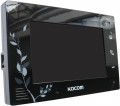Pluggable outdoor panels
The number of outdoor panels that can be connected to the intercom at the same time.
The call panel is an external panel through which the guest sends a call to the owner of the intercom and communicates with him. Such a panel should be at each door "covered" by the intercom. This means that the number of supported outdoor panels corresponds to the maximum number of doors with which this model can be used. The simplest option is
1 calling panel, but in fact this is often not enough. Therefore, models that can block
2 doors at once are more popular — for example, the main and service entrances to the office. And in the most advanced intercoms, it may be possible to connect
4 calling panels at once, or even
more.
Additional internal panels
The number of additional monitors that can be connected to the intercom at the same time.
This function is relevant only for video-enabled models — video intercoms and IP intercoms (see “Device type”). In such models, the intercom itself is called a monitor — an indoor unit with a screen. This paragraph indicates how many additional indoor units can be connected to this model. The need for such a connection arises in cases where access to the security system must be provided from several points at once — for example, in a private house on several floors, where it would be inconvenient to run from floor to floor to the intercom. In this case,
intercoms with access to 3 monitors,
4 monitors or more are appropriate.
Note that the format of multiple monitors working together may be different, see "Connection Type" for more details.
Consumption (standby)
The amount of energy consumed by the intercom in standby mode. In this mode, the device is energized and is in a state of readiness to receive a call; no functions are used, and the readiness itself does not require a lot of energy. Therefore, the value of this parameter, usually, is rather low, and you should pay attention to it only if you fundamentally strive for maximum efficiency of the installed equipment.
Consumption (during operation)
Power consumption of the intercom in the operating mode. Usually, this item indicates the value for situations where the device's functions are used to the fullest — in particular, when the display is on and the speakerphone is on (if any, see above). Note that the consumption in the operating mode rarely exceeds 20 W, so in most cases it is more of a reference, and not a practically significant parameter.
Operating temperature
The temperature range at which the intercom is able to work normally.
If the device is installed in a residential area or office, you can not pay much attention to this parameter: the temperature in such an environment rarely goes beyond +18 ... +25 °C, such values are normally tolerated by any intercom. But if the device needs to be placed in a "non-standard" microclimate — for example, an unheated warehouse, where conditions do not differ much from outdoor ones, or a production workshop with a high temperature — you should make sure that the chosen model can normally endure such conditions.
Separately, we note that even the most “heat-resistant” intercom cannot be exposed to prolonged exposure to sunlight.

